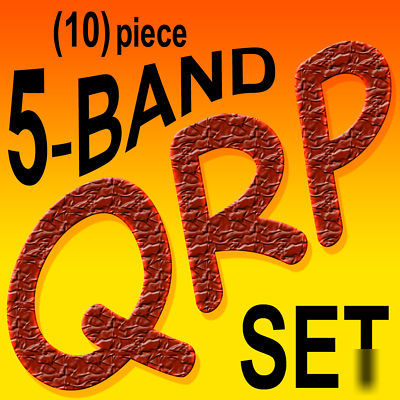Environmentally Conscious and Economically Sound Machine Dismantling Forum > Madison, WI
> Welding and Laser Cutting
> (10 pc) 5-bands ham qrp transmitter assortment 160M~6M
(10 pc) 5-bands ham qrp transmitter assortment 160M~6M
5 HAM Bands in a Variety of Package Styles and Features
DIP-8 & 14, Shielded Metal CAN, SMD, OE, VCXO
See below for chart, datasheets, schematics and more!
HAMs, this QRP assortment has something for all of you! These miniature transmitters (a.k.a. clock oscillators) all operate on HAM band frequencies.
Half have an Output Enable (OE) feature. (See explanation, schematics and chart below.)
You get ten frequencies in 5 HAM Bands.
With one exception, all are fixed frequency. The exception, #3 10M VCXO, tunes 6 kHz with 0 ~ +5 VDC to pin 1. Tune around the pileup or test your NBFM receiver with it.
Fixed price is for a set of (10) QRP Transmitters like the ones shown above. See detail chart below.
Units # 6 and #10 above are SMD but the leads are curled around the bottom and can be straightened or bent outward for easy soldering to the foil side of a PCB.
Standard CW Mode (left): This is the mode to use if your receiver has a BFO or product detector. It's the simplest configuration for all units. Note the location of pin 1 for orientation as viewed from the top. The 0.001 F bypass cap will increase stability if leads are long. It doesn't get any simpler!
At right is the wiring for the OE, Output Enable, feature. See the chart below to identify which ones have the OE function.
Keying the OE pin allows the oscillator to run continuously while turning the output on and off.
Below is an example of a MCW (Modulated CW) circuit. Use this circuit for CW communications if you have an AM-only receiver. Different resistors at pin 6 or capacitors at pin 2 in the NE555 timing circuit will produce different tones to distinguish different transmitters. Substitute a thermistor for the timing resistor (33K at pin 6) to make a simple temperature telemetry transmitter.
Output Enable Pin 1: +5 V enables; ground to disable.
VCXO Frequency specified with +2.5 volts applied to pin 1.
Click on PN for available datasheets.
LONG RANGE Of course range varies widely and avid QRP'ers know that it's the Antenna, Antenna, Antenna that is the key. But as an example, I've taken 6M and 10M units on the road, using just a short wire antenna (~6 ft, untuned) draped over the car seat, and they still reached out over 1 miles to a receiver connected to a roof level vertical. But the real potential comes with elevated antennas at both ends, especially beams. I estimate an RF output of 40 mW or more into a 50 load is possible with a 5.5 Volt supply.
* Model Rocket or Balloon Payload
* Remote Intrusion or Sensor Alarms
Elmers, add some excitement and realism to your code practice sessions by actually going on the air while you teach real life NET operating skills!
TRY THIS: Place a receiver in the classroom, and let several neophytes take turns at the key to "call" and communicate with each other using only their CW skills. No talking allowed. This can be a fun and effective learning tool.
Optional DIY Low Pass Filters (LPF)
The cutoff for this 20 Meter example is 19 MHz, well below the 2nd harmonic but with a wide buffer zone so loose part tolerances won't choke the fundamental frequency. The 0.66 H air core inductors can be handmade by close-winding 15T #22 on a " form. For other wire sizes and/or coil dimensions, go to the Approximate Air Coil Inductance Calculator to 'roll your own'.
This basic design is from the ARRL Radio Amateurs Handbook and is very easy to modify for other frequencies. We suggest choosing a cutoff midway between the transmit and 2nd harmonic frequencies. A cutoff well above the transmit frequency will relax part tolerances while still ensuring effective attenuation well ahead of the harmonics.
To adjust this design for other cutoff frequencies, it is important to understand that the component value changes will be inversely proportional to the frequency change. In other words, to double the cutoff frequency, halve the part values, and vice versa. Take the 160 Meter transmitter at 1.8 MHz for example. A 3dB cutoff at 2.5 MHz would work just fine. The 20 Meter LPF example is designed for 19 MHz. So to decrease the cutoff frequency, the part values need to be increased by the ratio of 19/2.5 = 7.6. Multiply all the values by 7.6 to calculate the values needed for the 2.5 MHz cutoff. The coils jump to 5 H and the caps rise to 1520 pF / 2736 pF / 1520 pF. These are not standard values but they are not critical due to the wide buffer zone between the fundamental and 2nd harmonic frequencies.
Check the ARRL Handbook for more information. They have normalized tables for many other LC combinations that may make a better match with your Junque Box inventory.
Substitutions are not allowed in this assortment, but additional quantities are available for some items.
If you've read all the way down to here and still have questions, please email us.
Note: Configurations and applications vary and performance varies. Please review FCC Rules and Regulations Part 15 and Part 97 if you are not certain your particular use is in compliance. The suggestions above are not intended to promote improper use. It is the amateur's responsibility to ensure the completed transmitter is in compliance and that it's operation does not interfere with other equipment.
